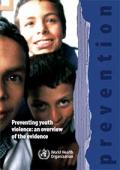Publications - Released in 2015
Each year an estimated 200 000 youth aged 10–29 years are murdered, making homicide the fourth leading cause of death in young people globally. In addition to these deaths, millions of young people sustain violence-related injuries that require emergency medical treatment, and countless others go on to develop mental health problems and adopt high-risk behaviours such as smoking, alcohol and drug abuse, and unsafe sex as a result of their exposure to youth violence. The emotional toll of youth violence on its victims, their loved ones and friends is high, and youth violence shatters lives. These consequences also have high economic costs, both for society and for the families of those affected.
The aim of this manual is to help policy-makers and planners everywhere – particularly in settings with limited human and financial resources – to address youth violence using an evidence-informed approach. The manual provides a science-based framework for understanding why some individuals are more likely to become involved in youth violence than others and why youth violence is more concentrated in particular communities and sectors of the population than in others. This framework incorporates a life-course approach that recognizes how behaviour in the present is shaped by earlier developmental stages. It also takes into account how youth violence is influenced by characteristics of the individual; family and peer relationships; and features of the community and society, such as economic inequality and high levels of alcohol consumption.
Downloads
Organizations
- World Health Organization (WHO)






